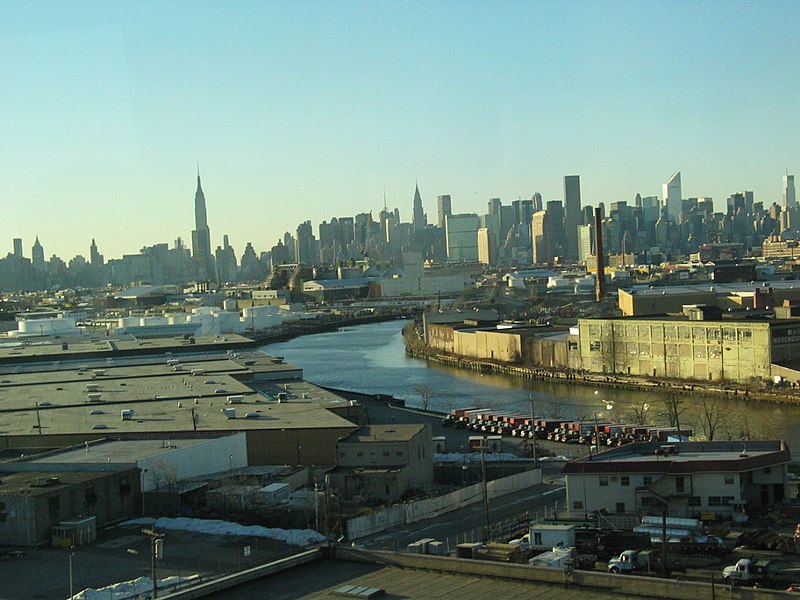Newtown Creek Exemplifies Our Government’s Agonizingly Slow Response to Environmental Cleanup
A walk along an urban creek sounds like a beautiful and peaceful way to spend a summer afternoon. Not so, however, at many places in America, especially the Newtown Creek waterfront in the curiously named Greenpoint area of Brooklyn.
A walk along Newtown Creek and many places like it is a visit to toxic brownfields — parcels of what could be valuable land that lie fallow because industrial solvents and wastes contaminate the soil and water. Beneath nearby Brooklyn streets lie potentially explosive concentrations of petrochemicals, testing showed in 2007. These empty old industrial lots each offer views of mucky, dark water.
Newtown Creek is just one of the estimated 450,000 brownfields in the United States.
The process remains mired in the discussion stage, precisely the situation in thousands of other brownfields across America.
Some of these sites, like Newtown Creek, are finally getting attention under the 1980 Comprehensive Environmental Response, Compensation and Liability Act, more commonly called the Superfund Law, which former President Jimmy Carter signed. However, many more sites sit empty and languishing in communities across the nation because that law is deeply flawed.
To clean up the site under the Superfund law involves a protected and complicated process, one that’s difficult for the public to participate in because it’s so technical.
Willis Elkins, president of the Newtown Creek Alliance, told DCReport about the frustrating Superfund rules.
‘Drawn-Out Process’
“That’s something that we try to work with the EPA on, and, fortunately, we do have a technical advisor and facilitator to help with our meetings,” Elkins said. Still, Elkins wrote, it’s “very difficult when at the end of the day what we want is a waterway that’s safe to interact with, and we have to go through a very technical, drawn-out process to understand how we might get there.”
Newtown Creek flows 3.8 miles. Along its banks, which separate the New York City boroughs of Brooklyn and Queens, toxic residues have despoiled 140 acres for more than a century.
European settlers had worked the land alongside the creek since the 1600s, when Dutch and then English farmers set up plantations. In the 1800s, factories began popping up, including the region’s first kerosene and oil refineries. In time the area became home to more than 50 refineries owned by John D. Rockefeller’s Standard Oil and others.
The 20th century brought canneries, copper wiring plants, fertilizer mixing, glue factories, leather tanneries, sawmills, shipping docks and sugar refineries, adding even more toxic wastes.
Decades of industrialization alone would have affected the surrounding environment. But added to this was dumping from factories beyond the creek banks, the city government and oil spills, all before environmental laws made such practices illegal.
The creek’s worst pollution came from what has become known as the Greenpoint oil spill, an accumulation of years of oil leaks from refineries owned by firms that eventually were bought up by ExxonMobil, Chevron-Texaco.and Amoco-BP.
ACTION BOX / What You Can Do About It
Want to get involved? You can contact the Newtown Creek Alliance here or reach out to the Newtown Creek Superfund site staff here.
Call the U.S. Capitol at 202-224-3121. Ask for your senators or representative by name.
Find your representative here (add your zip code in the URL) and write to them at: [Name] U.S. House of Representatives / Washington, D.C. 20515
Find your senators here and write to them at: [Name] United States Senate / Washington, D.C. 20510
The oil companies spilled between 17 million and 30 million gallons, the Newtown Creek Alliance estimates.
The spillage was officially noticed in 1978 when a U.S. Coast Guard patrol spotted oil flowing into the creek; an incident now called the Greenpoint oil spill. Subsequent testing revealed that oil seeped into 55 acres of the creek’s commercial, industrial and residential land.
ExxonMobile Oil Spill
Some recovery and remediation efforts by the companies, ordered by the state government, began, including ExxonMobil’s minimal 1979 cleanup attempts. That effort was more than undone in 1990 when the giant oil company spilled an additional 50,000 gallons of oil into the creek.
Since 1995, ExxonMobil has been slowly extracting and treating polluted groundwater. While it’s not clear how much longer the project needs to continue, more than 13 million gallons of chemicals have been recovered from the more than 6 billion gallons of groundwater recovered and treated through 2020.
In 2010, a third of a century after the Coast Guard officially identified a problem, the EPA finally designated Newtown Creek a Superfund site. That designation meant it’s supposed to undergo community-involved remediation and revitalization.
“EPA added the site to the National Priorities List (NPL) in 2010. Remedial investigations and fieldwork are ongoing,” the EPA’s New York State Superfund webpage says of the Newtown Creek.
But 11 years later, the process remains mired in the discussion stage, precisely the situation in thousands of other brownfields across America. And some despoiled lands have yet to be officially designated as Superfund sites.
This problem persists nationwide, with land spoiled by petroleum residues and other toxins not removed while endless negotiations and discussions drag on.
Sewage Overflows
At Newtown Creek, a Community Advisory Group connects residents to the Superfund cleanup process. It met on June 22 not to discuss cleaning toxins in the soil but to address sewage overflows.
Its most recent Zoom meeting, on July 21, featured a presentation from the New York City Department of Conservation’s Mike Haggerty. He gave the “annual update of the upland sites,” followed by community questions.
One disappointed participant, Laura Hofmann, told DCReport that she wasn’t surprised the update showed that the remediation plan hasn’t progressed.
“The Superfund process is definitely not going fast enough,” Hoffman said in an email. “Newtown Creek has had devastating effects on our community health over the many, many years… it’s incredible that this is still going on in 2021.”
Hoffman also said that since “our sewage treatment facility didn’t come into compliance with the 1972 Clean Water Act until 2010, I shouldn’t be surprised. This is a golden example of the level of concern our environmental and health agencies have for our community.
“Newtown Creek needs to be cleaned up, greened up, and put to use by clean operating entities with something to offer our community. After all, we’ve suffered enough.”
While studies and conversations abound, it doesn’t seem that cleanup work has started yet, aside from the minimal groundwater treatment ExxonMobil was already conducting.
Elkins, the creek alliance president, said, “There’s been a lot of frustration on the community’s part about the pace that we’re at, that we haven’t really began discussing cleanup scenarios in a substantial way.”
“It’s very frustrating for longtime residents that have had to deal with the impacts of the heavily polluted waterway in their backyard for so long to continue to have to wait further until we see any real action,” Elkins added.
Across America, the story is pretty much the same, raising the question of when, if ever, Congress will overhaul the Superfund law so that instead of studies and talks, we get a cleaner environment?




